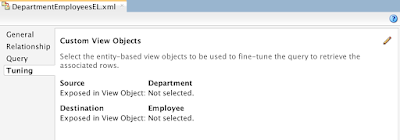Recently a good friend of mine was facing a regular problem with building an ADF application v.12.2.1.2 with the public Oracle Maven Repository. He asked me to check if it worked for me. Well... it didn't. So, there was some problem with the repository. In order to make the experiment clean and to avoid any impact on my working environment I decided to run the test in a docker container. And even though I could not help my friend (it simply didn't work throwing some dependency exception), as the result of this check I got a reusable docker image which serves as a preconfigured building machine for ADF applications (for v. 12.2.1.3 the Oracle Maven Repository worked fine at that moment).
This is what I did:
1. Pull and run an
ubuntu Docker image
$: docker run -it --name adfbuilder ubuntu
2. Install
Java in the
adfbuilder container
apt-get install software-properties-common python-software-properties
add-apt-repository ppa:webupd8team/java
apt-get update
apt-get install oracle-java8-installer
3. Install
Maven in the
adfbuilder container
Just download
maven binaries and unzip them in some folder and copy into the container:
docker cp ~/Downloads/apache-maven-3.5.2 adfbuilder:/opt/apache-maven-3.5.2
Update PATH environment variable in the container
export PATH=$PATH:/opt/apache-maven-3.5.2/bin
Having done that, the mvn should be available. Run it in the container and it will create a hidden .m2 folder in the user's home.
4. Configure Maven in the adfbuilder container to work with Oracle Maven Repository
Just put in the hidden .m2 folder
docker cp settings.xml adfbuilder:/root/.m2/settings.xml
settings.xml file with the following content:
<settings xmlns="http://maven.apache.org/SETTINGS/1.0.0" xmlns:xsi="http://www.w3.org/2001/XMLSchema-instance"
xsi:schemaLocation="http://maven.apache.org/SETTINGS/1.0.0 https://maven.apache.org/xsd/settings-1.0.0.xsd">
<servers>
<server>
<id>maven.oracle.com</id>
<username>eugene.fedorenko@flexagon.com</username>
<password><MY_PASSWORD></password>
<configuration>
<basicAuthScope>
<host>ANY</host>
<port>ANY</port>
<realm>OAM 11g</realm>
</basicAuthScope>
<httpConfiguration>
<all>
<params>
<property>
<name>http.protocol.allow-circular-redirects</name>
<value>%b,true</value>
</property>
</params>
</all>
</httpConfiguration>
</configuration>
</server>
</servers>
<profiles>
<profile>
<id>main</id>
<activation>
<activeByDefault>true</activeByDefault>
</activation>
<repositories>
<repository>
<id>maven.oracle.com</id>
<releases>
<enabled>true</enabled>
</releases>
<snapshots>
<enabled>false</enabled>
</snapshots>
<url>https://maven.oracle.com</url>
<layout>default</layout>
</repository>
</repositories>
<pluginRepositories>
<pluginRepository>
<id>maven.oracle.com</id>
<url>https://maven.oracle.com</url>
</pluginRepository>
</pluginRepositories>
</profile>
</profiles>
</settings>
Basically, this is enough to compile a Maven-configured ADF application in the container. We need to make sure that there is an access to the source code of our application from the container. This can be done either by mapping a source folder to be visible from the container or just by coping it into the container.
docker cp /mywork/MySampleApp adfbuilder:/opt/MySampleApp
Having done that, we can run the following command to get the application compiled:
docker exec adfbuilder mvn -f /opt/MySampleApp/pom.xml compile
5. Copy JDeveloper binaries into the container
As we want to go beyond this point and be able not only to compile, but to produce deployable artifacts (ears, jars, etc.), we will need to put JDeveloper binaries into the container (basically,
maven will need
ojdeploy). I have just copied Oracle_Home folder from my Mac to the container:
docker cp /My_Oracle_Home adfbuilder:/opt/Oracle_Home
So, now I am able to build a
ear for my application in the container:
docker exec adfbuilder mvn -f /opt/MySampleApp/pom.xml package -DoracleHome=/opt/Oracle_Home
For the first run it may ask you to provide you the path to your JDK
[INFO] Type the full pathname of a JDK installation (or Ctrl-C to quit), the path will be stored in /root/.jdeveloper/12.2.1.3.0/product.conf
/usr/lib/jvm/java-8-oracle
6. Commit changes to the container
The final thing we need to do is to commit changes to the container:
docker commit adfbuilder efedorenko/adfbuilder
This will create a new
ubuntu image containing all changes that we applied. We can easily run that image wherever we want across our infrastructure and use it as a building machine for ADF applications. The beauty of it is that we can run it in a cloud like Docker Cloud (backed by AWS, Microsoft Azure, Digital Ocean, etc.) or Oracle Container Cloud Services or whatever you prefer. With this approach servers in the cloud build your application for you which in general is a quite resource-consuming job.
Thant's it!









